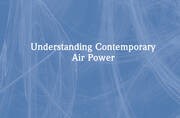
Contemporary air power refers to the use of advanced air assets and technologies to achieve military objectives in modern warfare. This can include a wide range of platforms, such as fighter jets, bombers, drones, helicopters, and fixed-wing combat support aircraft, as well as advanced weapon systems and sensor networks.
One of the key features of contemporary air power is its ability to provide a range of capabilities, including air superiority, precision strike, reconnaissance, mobility, and humanitarian support. For example, fighter jets and drones can be used to gain air superiority and conduct precision strikes against enemy targets, while combat support aircraft and helicopters can provide rapid mobility for troops and supplies. In addition, air power can be used to complement surface operations and to conduct humanitarian operations such as disaster relief and search and rescue.
Contemporary air power thought is a complex and evolving field of study that encompasses a range of topics related to the use of air power in modern warfare. Some of the key concepts and ideas that are central to contemporary air power thought include:
- The Role of Air Power in Modern Warfare: Modern air power is an essential element of military strategy, capable of achieving a range of objectives including reconnaissance, air superiority, precision strike, and mobility. Air power can also be used to complement surface operations and conduct humanitarian operations.
- The Evolution of Air Power: Air power has evolved significantly over the past century, from its earliest days as a reconnaissance tool to its current status as a highly advanced and versatile military asset. Today, air power includes a wide range of platforms including fighter jets, drones, helicopters, and bombers.
- The importance of Technology: Technology plays a critical role in contemporary air power, enabling the development of advanced weapons systems, sensor networks, and communication technologies. The use of artificial intelligence, machine learning, and autonomous systems is also becoming increasingly important in the field of air power.
- Weapons and Targeting: Airpower relies on advanced weapon systems, such as precision-guided munitions and air-to-air missiles that enable pilots to engage enemy targets with extreme accuracy and minimal collateral damage.
- The role of Doctrine: Military doctrine plays a critical role in shaping the use of air power in modern warfare. Doctrine provides a framework for decision-making and helps guide the development of tactics and strategies that can be applied across different campaigns of operation.
- Importance of Strategy and Tactics: contemporary air power also involves the development of appropriate strategy and tactics. This includes the use of strategies such as air interdiction, suppression of enemy air defenses, and joint air-ground operations, as well as the development of tactics that enable air assets to operate effectively in a range of environments and against a range of threats.
Contemporary air power is a critical element of modern warfare, enabling militaries to achieve a range of objectives quickly and efficiently using advanced technologies and tactics.
Contemporary air power thought is a dynamic and constantly evolving field that reflects the changing nature of modern warfare and the ongoing development of advanced military technologies.
Bottom Line
The application of air power is both a science and an art.
The need of the hour is – THINKING air warriors
Suggestions and value additions are most welcome
For regular updates, please register here
References and credits
To all the online sites and channels.
Disclaimer:
Information and data included in the blog are for educational & non-commercial purposes only and have been carefully adapted, excerpted, or edited from sources deemed reliable and accurate. All copyrighted material belongs to respective owners and is provided only for purposes of wider dissemination.
